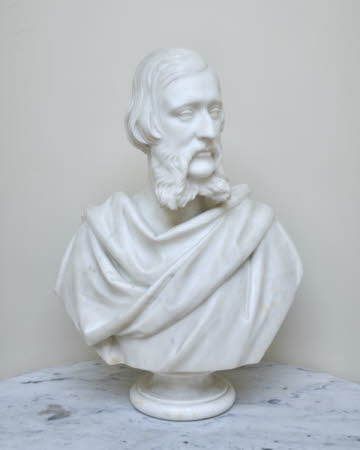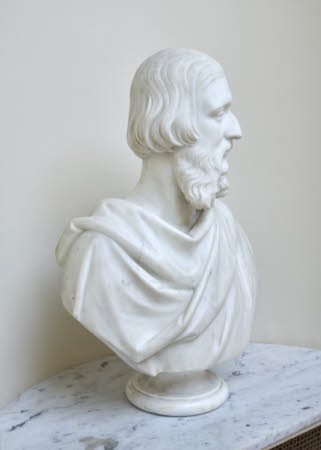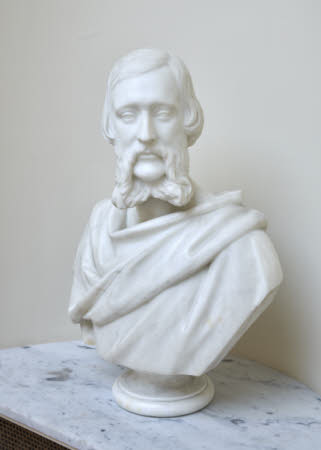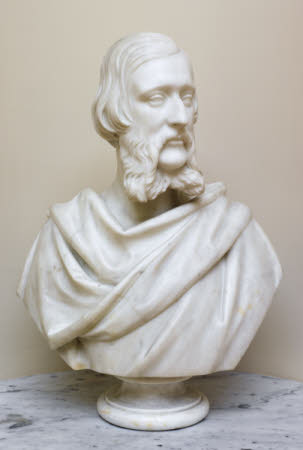Portrait bust of Lord Adolphus Vane-Tempest (1825-64)
John Edward Jones (Dublin 1806 - Finglas 1862)
Category
Art / Sculpture
Date
1857 (signed and dated) - 1858 (exh at RA)
Materials
Marble
Measurements
648 mm (25 1/2 in) high
Place of origin
London
Order this imageCollection
Mount Stewart, County Down
NT 1542335
Caption
John Edward Jones, son of a miniature-painter, was born in Dublin. He was described as possessing ‘a kind, courteous and generous disposition’, while ‘in wit, humour and vivacity he was a thorough Irishman’. He originally trained as a civil engineer under Alexander Nimmo and was employed with him on various important works in Ireland, including the building of Waterford Bridge, 1829-32. However, he abandoned engineering for sculpture in 1840. He exhibited, mainly portrait busts, at the Royal Hibernian Academy between 1847 and 1854 and at the Royal Academy in London, 1842-62 to great acclaim. This portrait bust of is the 3rd son of the second marriage of the 3rd Marquess of Londonderry, exhibited in 1858.
Summary
Sculpture, marble; portrait bust of Lord Adolphus Frederick Vane-Tempest (1825-1864); John Edward Jones (1806-1862); 1858. One a group of four portrait busts commissioned from the Irish sculptor John Edward Jones in 1857 and 1858, depicting Frances Anne Vane, Marchioness of Londonderry, two of her children and a daughter-in-law. Lord Adolphus became unsound in mind after service during the Crimean War and died tragically young.
Full description
A marble portrait bust by John Edward Jones, depicting Lord Adolphus Vane-Tempest (1825-64), depicting the sitter facing to the left, draped in a shapeless cloak, with moustache and a prominent bifurcated beard. On a turned marble soclee. Signed and dated on the back. One of a group of four portrait busts commissioned in 1857 and 1858 from the London-based Irish sculptor John Edward Jones, depicting the widowed Lady Londonderry, two of her children and a daughter-in-law. The other portraits, all dated 1858, are of Frances Anne Vane, Marchioness of Londonderry (NT 1542342), her eldest son George Vane-Tempest, later 5th Marquess of Londonderry (NT 1542336), and his wife Maria Cornelia (NT 1542343). Lord Adolphus Vane-Tempest was said to have been the favourite from among his mother’s six children. Even as a young man, he earned a reputation for reckless behaviour; in January 1850, he was responsible for his elder brother Lord Vane being blinded in one eye, as the result of a shooting accident. From 1854 until his death in 1864, he was the Member of Parliament for North Durham. An officer in the army, popularly known by his fellow officers as Dolly Vane, he served in 1854-55 in the Crimean War, including the siege of Sebastopol, where he was horrified by the appalling conditions in which his men had to live and fight. Adolphus was awarded a medal for bravery and was given a hero’s welcome when he visited his constituency following his return from the Crimea. He continued to campaign in Parliament for improvements to soldiers' conditions. However, perhaps suffering from today’s recognised condition of Post Traumatic Stress Disorder (PTSD), by 1857 Lord Adolphus had suffered a breakdown and thereafter he quickly descended into severe and sometimes violent mental illness, and also became an alcoholic. He fell in love with the much younger Lady Susan Pelham-Clinton, daughter of the Duke of Newcastle, marrying her in April 1860. Already on their honeymoon it was reported that ‘Adolphus Vane has gone mad again and threw a decanter and knives and forks at her [his bride]’. Queen Victoria, who took a close interest in Lord Adolphus's decline, noted that he had ‘a natural tendency to madness'. In 1861 Adolphus Vane-Tempest was committed to a mental hospital although he was subsequently able to return home, a son being born in 1863. However, he continued to suffer increasingly frequent attacks and in early 1864 is said to have sailed to America to seek remedy for his illness, but returned in a worse state. He died on 11 June 1864, from a burst blood vessel when struggling with his four keepers who were attempting to restrain him. John Edward Jones was born in Dublin and began his professional career as an engineer working both in Ireland and in Britain. He also however showed aptitude as an amateur sculptor and draughtsman. In around 1840 Jones decided to change career to become a professional artist, based in London. He enjoyed considerable success as a portrait sculptor, frequently exhibiting at the Royal Academy in London and at the Royal Hibernian Academy in Dublin. Jeremy Warren June 2022
Provenance
Wynyard Park; on loan from the Estate of the Marquess of Londonderry
Credit line
Estate of the Marquess of Londonderry
Marks and inscriptions
On back:: J.E. JONES. Sc./ LONDON. 1857
Makers and roles
John Edward Jones (Dublin 1806 - Finglas 1862), sculptor
References
Royal Academy, 1858, p. 51, no. 1299. Wynyard 1949: Inventory and Valuation of the Contents of Wynyard Park, Co. Durham, the property of the Most Honourable the Marquess of Londonderry… deceased. Prepared for the purpose of probate by H. Clifford-Smith. 1949, p. 35. Roscoe 2009: I. Roscoe, E. Hardy and M. G. Sullivan, A Biographical Dictionary of Sculptors in Britain 1660-1851, New Haven and Yale 2009, p. 674, no. 120.





